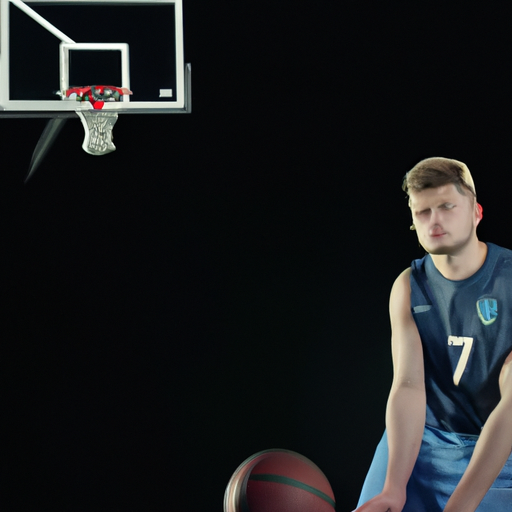Luka Doncic addresses lingering injury ahead of FIBA World Cup

The Impact of Luka Doncic’s Injury on Slovenia’s FIBA World Cup Campaign
Luka Doncic, the Slovenian basketball sensation, has been making headlines once again, but this time it’s not for his incredible on-court performances. Instead, it’s his lingering injury that has become the center of attention as Slovenia prepares for the upcoming FIBA World Cup.
Doncic, who plays for the Dallas Mavericks in the NBA, suffered a sprained ankle towards the end of the regular season. While the injury didn’t require surgery, it did force him to miss a few games and raised concerns about his availability for the FIBA World Cup.
The impact of Doncic’s injury on Slovenia’s campaign cannot be understated. As one of the team’s key players, his absence would undoubtedly be felt on both ends of the court. Doncic’s ability to score, create plays, and control the tempo of the game is unmatched, and his absence would leave a significant void in Slovenia’s offense.
Furthermore, Doncic’s injury also raises questions about his fitness and form heading into the tournament. An ankle injury can have a lasting impact on a player’s mobility and explosiveness, both of which are crucial in the fast-paced game of basketball. It remains to be seen whether Doncic will be able to perform at his usual high level or if he will be limited by his injury.
However, despite the concerns surrounding his injury, Doncic remains optimistic about his chances of participating in the FIBA World Cup. In a recent interview, he expressed his determination to represent his country and help Slovenia achieve success on the international stage. Doncic’s commitment to his national team is commendable, and his presence on the court would undoubtedly boost Slovenia’s chances of making a deep run in the tournament.
The Slovenian Basketball Federation has been closely monitoring Doncic’s recovery and has been in constant communication with the Dallas Mavericks’ medical staff. They are taking a cautious approach to ensure that Doncic is fully fit and ready to compete at the highest level. The federation understands the importance of having their star player healthy and will not rush his return if it jeopardizes his long-term well-being.
In the meantime, Slovenia’s coaching staff is working on contingency plans in case Doncic is unable to participate in the FIBA World Cup. They are exploring different lineup combinations and strategies that can maximize the team’s strengths and minimize the impact of Doncic’s absence. While it is impossible to completely replace a player of Doncic’s caliber, the team is confident in their ability to adapt and compete at a high level.
As the FIBA World Cup draws nearer, the basketball world eagerly awaits updates on Doncic’s injury status. His presence on the court would undoubtedly elevate the tournament’s excitement and add another layer of competitiveness. However, regardless of whether Doncic is able to play or not, Slovenia’s national team remains a formidable opponent and should not be underestimated.
In conclusion, Luka Doncic’s lingering injury has cast a shadow of uncertainty over Slovenia’s FIBA World Cup campaign. His absence would undoubtedly impact the team’s performance, but his determination to represent his country gives hope to Slovenian fans. The Slovenian Basketball Federation is taking a cautious approach to ensure Doncic’s long-term well-being, while the coaching staff is preparing contingency plans. Regardless of the outcome, Slovenia’s national team remains a force to be reckoned with, and their performance in the FIBA World Cup will be closely watched by basketball enthusiasts around the globe.
Luka Doncic’s Road to Recovery: A Closer Look at His Rehabilitation Process

Luka Doncic, the Slovenian basketball prodigy, has been making headlines for his exceptional skills on the court. However, recently, his fans were left concerned when news broke out about a lingering injury that could potentially affect his performance in the upcoming FIBA World Cup. Doncic, being the dedicated athlete that he is, wasted no time in addressing the issue and taking the necessary steps towards recovery.
The injury in question is a sprained ankle that Doncic sustained during a game earlier this year. Despite the initial setback, he continued to play through the pain, showcasing his determination and commitment to his team. However, as the FIBA World Cup approached, it became evident that a more comprehensive approach to his rehabilitation was required.
Doncic’s rehabilitation process began with a thorough assessment by a team of medical professionals. They conducted a series of tests to determine the extent of the injury and to identify any underlying issues that may have contributed to its occurrence. This step was crucial in developing a tailored treatment plan that would address Doncic’s specific needs.
The first phase of Doncic’s rehabilitation focused on reducing pain and inflammation. This involved a combination of rest, ice, compression, and elevation, commonly known as the RICE method. By following this protocol, Doncic was able to alleviate discomfort and promote healing in the affected area.
Once the initial pain and swelling subsided, Doncic transitioned into the next phase of his rehabilitation, which involved a range of motion exercises. These exercises aimed to restore flexibility and mobility in his ankle joint, which had been compromised due to the injury. Doncic worked closely with a physical therapist who guided him through a series of stretching and strengthening exercises, gradually increasing the intensity as his ankle improved.
As Doncic regained strength and stability in his ankle, he moved on to the third phase of his rehabilitation, which focused on functional exercises. These exercises were designed to simulate basketball-specific movements and challenges, allowing Doncic to regain his agility and coordination on the court. Under the watchful eye of his trainers, he practiced dribbling, shooting, and cutting, gradually reintegrating himself into the game.
Throughout his rehabilitation process, Doncic also received regular sessions of manual therapy, such as massage and joint mobilization. These techniques helped to further reduce pain, improve circulation, and enhance tissue healing. Additionally, Doncic underwent regular evaluations to monitor his progress and make any necessary adjustments to his treatment plan.
As the FIBA World Cup draws near, Doncic’s dedication to his rehabilitation has paid off. He has made significant strides in his recovery and is now confident in his ability to perform at his best. Doncic’s journey serves as a testament to his resilience and determination, as well as the importance of a comprehensive rehabilitation process in overcoming injuries.
In conclusion, Luka Doncic’s road to recovery has been a meticulous and well-structured process. From the initial assessment to the final stages of functional training, every step has been carefully planned to ensure his successful return to the court. Doncic’s commitment to his rehabilitation serves as an inspiration to athletes worldwide, reminding them that with the right mindset and proper care, they can overcome any obstacle and achieve greatness.
Analyzing the Potential Consequences of Luka Doncic’s Lingering Injury for the Dallas Mavericks
Luka Doncic, the rising star of the Dallas Mavericks, has been dealing with a lingering injury that has raised concerns among fans and analysts alike. As the FIBA World Cup approaches, Doncic’s injury has become a topic of discussion, with many wondering how it could potentially impact his performance and the overall success of the Mavericks in the upcoming NBA season.
Doncic’s injury, a sprained ankle, occurred during a game against the Miami Heat last season. Despite the injury, Doncic continued to play through the pain, showcasing his determination and commitment to his team. However, the decision to play through the injury may have had consequences that are now surfacing.
One potential consequence of Doncic’s lingering injury is the risk of aggravating it further during the FIBA World Cup. The tournament, which features some of the best basketball players from around the world, is known for its intense competition and physicality. If Doncic is not fully healed, he may be more susceptible to re-injury, which could have long-term implications for his career and the Mavericks’ success.
Another consequence of Doncic’s injury is the potential impact on his conditioning and overall performance. An ankle injury can limit a player’s mobility and agility, two crucial aspects of Doncic’s game. If he is unable to move as fluidly as he did before the injury, it could affect his ability to drive to the basket, create scoring opportunities for his teammates, and defend against opponents effectively. This could ultimately hinder the Mavericks’ offensive and defensive strategies, as Doncic plays a pivotal role in both areas.
Furthermore, Doncic’s injury could also have psychological effects on his game. Injuries can often lead to a loss of confidence and a fear of re-injury. If Doncic is constantly worried about aggravating his ankle, it could impact his decision-making on the court and his willingness to take risks. This could result in a more cautious and less aggressive style of play, which may not be as effective as his usual fearless approach. The mental aspect of the game is just as important as the physical, and any doubts or hesitations could hinder Doncic’s performance and the Mavericks’ overall success.
The Dallas Mavericks have invested heavily in Doncic, both financially and strategically. They see him as the future of the franchise and have built their team around his unique skill set. If Doncic’s injury lingers and affects his performance, it could have a ripple effect on the team’s chemistry and dynamics. Other players may have to step up and take on a larger role, which could disrupt the team’s established rhythm and game plan.
In conclusion, Luka Doncic’s lingering injury ahead of the FIBA World Cup raises concerns about its potential consequences for the Dallas Mavericks. The risk of re-injury, the impact on his conditioning and performance, the psychological effects, and the potential disruption to the team’s dynamics are all factors that need to be considered. As fans eagerly await Doncic’s return to the court, it remains to be seen how his injury will ultimately affect his game and the Mavericks’ success in the upcoming NBA season.

